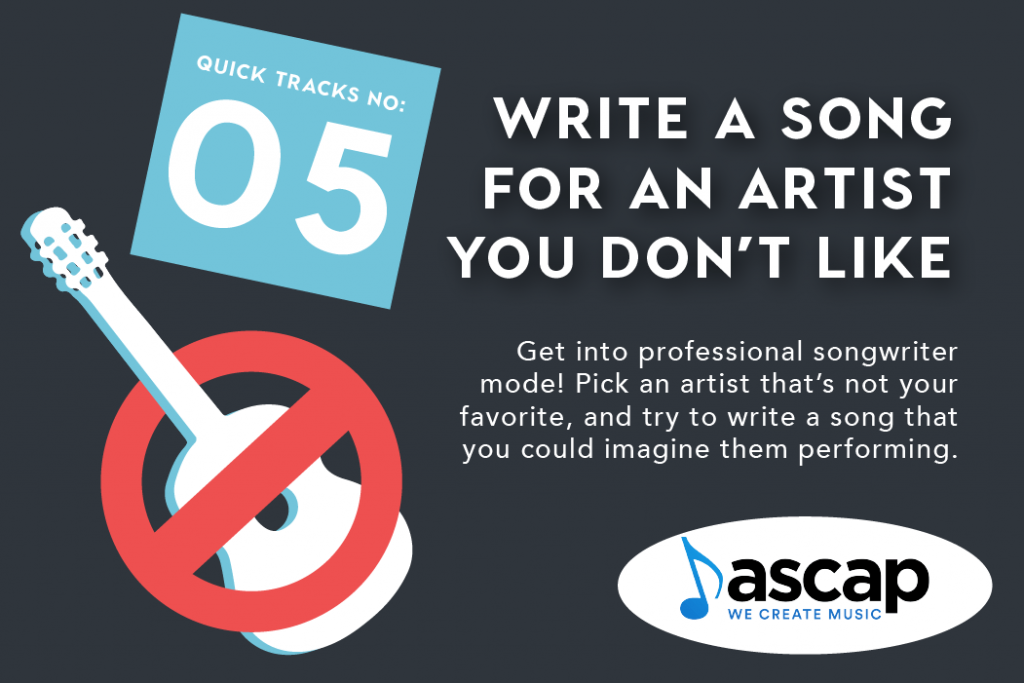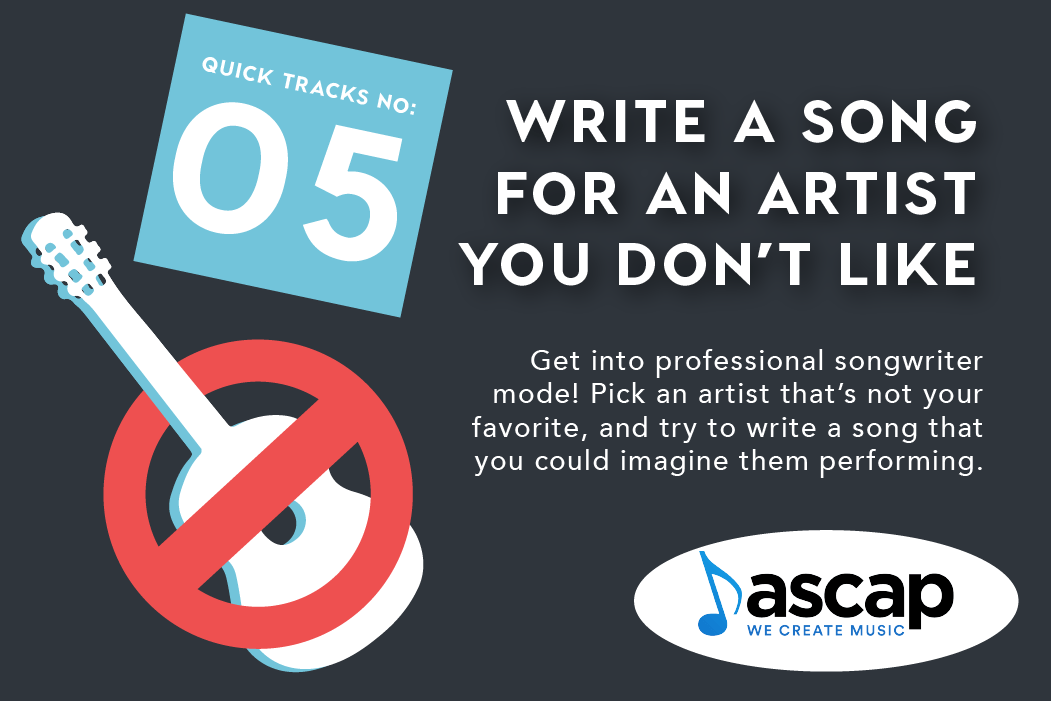Welcome back to the dance floor, Quick Trackers! Once a month, we hook you up with a short production or songwriting challenge, aimed at helping to up your musicianship. To respond to the challenge, just email us, leave a comment, or post to social media with the hashtag #quicktracks and tag us @learntosoundfly.
This week, we’ve got another challenge brought to us by the songwriting masters over at ASCAP. If you don’t know what ASCAP is, it’s the American Society of Composers, Authors and Publishers, and they represent the rights of songwriters in getting royalties for public performances of their work. In other words, these guys know a thing or two about great songwriting, having represented many of the greats of all time, starting with Irving Berlin and George Gershwin and continuing up to Beyoncé and Justin Timberlake today.
The challenge they sent us was to write a song for an artist you don’t like. Huh? Let’s take a closer look.
It makes sense that this challenge would come from ASCAP, as many of their songwriters write music for other people to perform. Doing this sort of thing can help make you a more versatile and flexible songwriter which will open you up to more artists willing to work with you.
Regardless of your ultimate goal, this is one of the best ways to gain practice as a songwriter, because it requires you to totally immerse yourself in the musical choices that an artist makes. And if it’s an artist you don’t like, the process will certainly push you outside of your comfort zone a little bit since you’re most likely not already making music in that style. So go ahead, pick an artist out there whose music just happens to not be your favorite, and do your best to write a song that you could imagine that artist performing.
The World of Sound-Alikes
One of the reasons we really liked this challenge is that it’s not dissimilar to something that many of us were challenged to do in music school: create sound-alikes of popular songs. A sound-alike is exactly what it sounds like — a piece of music that mimics the sound of a particular recording or song.
Obviously, as artists, creating sound-alikes is not the thing that gets us up in the morning. We’re all about original artistic expression. But from a learning standpoint, sound-alikes force you to dive deep into the choices an artist has made regarding their song structure, harmonies, instrumentation, sound design, and much more.
We’re not saying that you need to create a sound-alike for this challenge, but you should definitely start by listening to some music by the artist you selected and begin to deconstruct the elements that make that artist stand out.
How to Create a Song in a Different Style
So how do you go about creating a song in a different artist’s style? There are lots of ways to approach this challenge. If you’re more of a classic songwriter, feel free to simply use your instrument of choice and write a song trying to incorporate any themes you feel like appear often in the artist’s work. No need to overthink it.
However, if you’re more of a producer and comfortable in a DAW, you might also consider approaching it in a similar way to how you might go about creating a sound-alike to get as close as you can to the artist’s current style. Let’s outline one approach below in a few steps:
Step 1: Listen to a few songs and choose a reference track. Go ahead and listen to a bunch of different songs by the artist you’ve selected and choose one as a reference that you think is particularly emblematic of their style.
Step 2: Download your reference track and load it up into a DAW. Pull the track into your DAW of choice so you can easily mute and un-mute it while crafting your own version.
Step 3: Create an instrument list. Begin to choose which instruments your song is going to have, using the reference track as a starting place.
Step 4: Choose a tempo. Once again, use your reference track as a guide.
Step 5: Choose a structure. What type of songs does your artist normally play? Do they have a few verses, a chorus, and a bridge, or is there more complexity than that? Consider using your reference track as guide and make some markers in your DAW for the various sections in your reference track.
Step 6: Start with the rhythmic instruments. Start by trying to mimic the rhythms of the drums in your reference track, beginning with the kick. Don’t worry too much about shaping your sounds until you’ve got the rhythms right.
Step 7: Fill in the other main “song elements.” This includes the other instruments you listed above.
Step 8: Look for patches that better match the sounds of your reference. Once you’ve got all your instruments in there, you can spend a bit more time tweaking and adjusting your sounds to get them closer to the sounds of the reference. (If it’s digital strings, we can help, and if it’s digital synths, we can help with that, too!)
Step 9: A/B Test sounds against your reference. As you hone in on your sounds, spend some time A/B testing them against the reference track you chose to try to get it as close to how the artist likes it as possible.
Once you’ve got something, feel free to make some key changes to give it a little more originality. By the end, take a moment to consider: What did you learn about your artist’s song elements? What parts of the work made you not like it? Are there any parts you do like and might choose to learn from?
As songwriters, we’re always learning, pulling inspiration from across the spectrum. Sometimes the best lessons come from the places you least expect them!
Share your work with us!
Get 1:1 coaching on your music from a seasoned pro.
Soundfly’s community of mentors can help you set the right goals, pave the right path toward success, and stick to schedules and routines that you develop together, so you improve every step of the way. Tell us what you’re working on, and we’ll find the right mentor for you!





